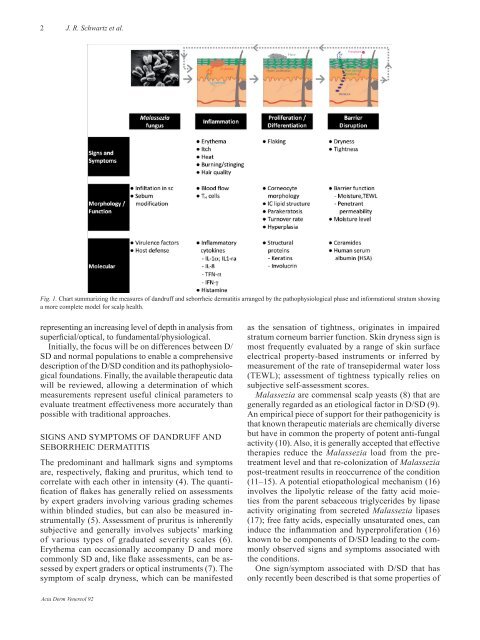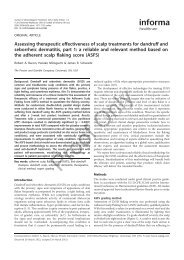A Comprehensive Pathophysiology of Dandruff and Seborrheic ...
A Comprehensive Pathophysiology of Dandruff and Seborrheic ...
A Comprehensive Pathophysiology of Dandruff and Seborrheic ...
You also want an ePaper? Increase the reach of your titles
YUMPU automatically turns print PDFs into web optimized ePapers that Google loves.
2 J. R. Schwartz et al.<br />
Fig. 1. Chart summarizing the measures <strong>of</strong> d<strong>and</strong>ruff <strong>and</strong> seborrheic dermatitis arranged by the pathophysiological phase <strong>and</strong> informational stratum showing<br />
a more complete model for scalp health.<br />
representing an increasing level <strong>of</strong> depth in analysis from<br />
superficial/optical, to fundamental/physiological.<br />
Initially, the focus will be on differences between D/<br />
SD <strong>and</strong> normal populations to enable a comprehensive<br />
description <strong>of</strong> the D/SD condition <strong>and</strong> its pathophysiological<br />
foundations. Finally, the available therapeutic data<br />
will be reviewed, allowing a determination <strong>of</strong> which<br />
measurements represent useful clinical parameters to<br />
evaluate treatment effectiveness more accurately than<br />
possible with traditional approaches.<br />
SIGNS AND SyMPToMS oF DANDRUFF AND<br />
SEBoRRHEIC DERMATITIS<br />
The predominant <strong>and</strong> hallmark signs <strong>and</strong> symptoms<br />
are, respectively, flaking <strong>and</strong> pruritus, which tend to<br />
correlate with each other in intensity (4). The quantification<br />
<strong>of</strong> flakes has generally relied on assessments<br />
by expert graders involving various grading schemes<br />
within blinded studies, but can also be measured instrumentally<br />
(5). Assessment <strong>of</strong> pruritus is inherently<br />
subjective <strong>and</strong> generally involves subjects’ marking<br />
<strong>of</strong> various types <strong>of</strong> graduated severity scales (6).<br />
Erythema can occasionally accompany D <strong>and</strong> more<br />
commonly SD <strong>and</strong>, like flake assessments, can be assessed<br />
by expert graders or optical instruments (7). The<br />
symptom <strong>of</strong> scalp dryness, which can be manifested<br />
Acta Derm Venereol 92<br />
as the sensation <strong>of</strong> tightness, originates in impaired<br />
stratum corneum barrier function. Skin dryness sign is<br />
most frequently evaluated by a range <strong>of</strong> skin surface<br />
electrical property-based instruments or inferred by<br />
measurement <strong>of</strong> the rate <strong>of</strong> transepidermal water loss<br />
(TEwL); assessment <strong>of</strong> tightness typically relies on<br />
subjective self-assessment scores.<br />
Malassezia are commensal scalp yeasts (8) that are<br />
generally regarded as an etiological factor in D/SD (9).<br />
An empirical piece <strong>of</strong> support for their pathogenicity is<br />
that known therapeutic materials are chemically diverse<br />
but have in common the property <strong>of</strong> potent anti-fungal<br />
activity (10). Also, it is generally accepted that effective<br />
therapies reduce the Malassezia load from the pretreatment<br />
level <strong>and</strong> that re-colonization <strong>of</strong> Malassezia<br />
post-treatment results in reoccurrence <strong>of</strong> the condition<br />
(11–15). A potential etiopathological mechanism (16)<br />
involves the lipolytic release <strong>of</strong> the fatty acid moieties<br />
from the parent sebaceous triglycerides by lipase<br />
activity originating from secreted Malassezia lipases<br />
(17); free fatty acids, especially unsaturated ones, can<br />
induce the inflammation <strong>and</strong> hyperproliferation (16)<br />
known to be components <strong>of</strong> D/SD leading to the commonly<br />
observed signs <strong>and</strong> symptoms associated with<br />
the conditions.<br />
one sign/symptom associated with D/SD that has<br />
only recently been described is that some properties <strong>of</strong>



